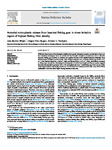Potential microplastic release from beached fishing gear in Great Britain's region of highest fishing litter density

Date
2021-12Author
Subject
Metadata
Show full item recordAbstract
While land-based sources of marine plastic pollution have gained widespread attention, marine-based sources are less extensively investigated. Here, we provide the first in-depth description of abandoned, lost or otherwise discarded fishing gear (ALDFG) on northern and southern beaches of the English Southwest Peninsula, Great Britain's region of highest ALDFG density. Three distinct categories were recorded: twisted rope (0.28 ± 0.14 m-1, 17%), braided rope (0.56 ± 0.28 m-1, 33%) and filament (0.84 ± 0.41 m-1, 50%), which likely correspond to fishing rope, net and line. Estimating the disintegration of ALDFG from length and filament number suggests that it has the potential to generate 1277 ± 431 microplastic pieces m-1, with fishing rope (44%) and net (49%) as the largest emitters. Importantly, ALDFG was over five times more abundant on the south coast, which is likely attributable to the three times higher fishing intensity in that area.
Collections
Publisher
Place of Publication
Journal
Volume
Issue
Pagination
Number
Recommended, similar items
The following license files are associated with this item:

